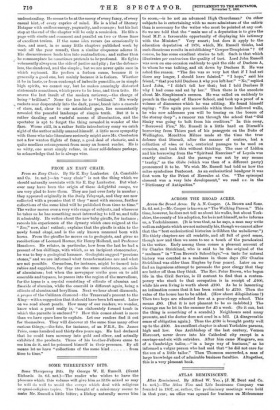FROM AN EASY CHAIR.
From an Easy Chair. By Sir E. Ray Lankester. (A. Constable and Co. is. net.)—An "easy chair" is not the thing which we should naturally associate with Sir E. Ray Lankester. But what- ever may have been the origin of these delightful essays, we are very glad to have them. They are just over, forty in number ; they appeared originally in the Daily Telegraph, and they are now collected with a promise that if they "meet with success, further collections of the same kind will be published from time to time." The writer moves over a very wide range of subjects, and wherever he takes us he has something most interesting to tell us, and tells it admirably. He writes about the new baby giraffe, for instance ; records his experiences of the dynasty which once reigned at the " Zoo," now, alas ! extinct; explains that the giraffe is akin to the newly found okapi, and is the only known mammal born with horns. From the giraffes he moves on to geologists, and gives us recollections of Leonard Homer, Sir Henry Holland, and Professor Henslowe. He relates, in particular, how from the last he had a present of ten shillings, with which, as an incipient stonecracker, he was to buy a geological hammer. Geologists suggest " precious stones," and we are informed what transformations are and what are not possible: Corundum, for instance, might be turned into rabiea and sapphires, for they are the same substance, an oxide of aluminium ; but when the newspaper •scribe goes on to add emeralds and topazes, he passes into the region of the marvellous, for the topaz is 'a crystal consisting of silicate of alumina and fluoride of alumina, while the emerald is different again, being a silicate of alumina and beryllium. Next we hear about diamonds, a.propos of the Cullinan diamond—the Transvaal's present to the King—with a suggestion that it should have been left uncut. Later on we read about pearls. How many of our readers, we wonder, know what a pearl really is, "an elaborately formed tomb in .which the parasite is enclosed " ? How this comes about is more than wahave spacelere to explain. Let our readers find it out for themselves. • They will discover at the same time many other curious things,—the fate, for instance, of an F.R.S., Dr. James Price, some hundred and thirty-five years ago. He had declared that he could turn mercury into -gold and silver, and actually exhibited the products. Three of his brother-Fellows came to see him do it, and he poisoned himself in their presence. ' By all
means let us have "collections of the same kind from time to time."




























































 Previous page
Previous page